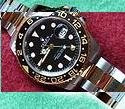 Rolex watches are popularly considered status symbols. Rolex is the largest single luxury watch brand by far, producing about 2,000 watches per day, BusinessWeek magazine ranks Rolex 71 on its 2007 annual list of the 100 most valuable global brands, top among all watchmakers.
Rolex watches are popularly considered status symbols. Rolex is the largest single luxury watch brand by far, producing about 2,000 watches per day, BusinessWeek magazine ranks Rolex 71 on its 2007 annual list of the 100 most valuable global brands, top among all watchmakers.Rolex SA is a Swiss manufacturer of wristwatches and accessories.
In 1905 Hans Wilsdorf and his brother-in-law Alfred Davis founded "Wilsdorf and Davis" in London. Their main business at the time was importing Hermann Aegler's Swiss movements to England and placing them in quality cases made by Dennison and others. These early wristwatches were sold to jewellers, who then put their own names on the dial. The earliest watches from Wilsdorf and Davis were usually hallmarked "W&D" inside the caseback.
Rolex :
In 1908 Wilsdorf registered the trademark "Rolex" and opened an office in La Chaux-de-Fonds, Switzerland. The company name "Rolex" was registered on 15 November 1915. The word was made up, and its origin is obscure. Wilsdorf was said to want his watch brand's name to be easily pronounceable in any language. One story, never confirmed by Wilsdorf, is that the name came from the French phrase horlogerie exquise, meaning "exquisite clockwork". Another story claims that "rolex" was meant to evoke the sound of a watch being wound. The book The Best of Time: Rolex Wristwatches: An Unauthorized History by Jeffrey P. Hess and James Dowling says that the name was just made up. The Book A Movement in Time with Breitling & Rolex by Mark A Cooper states that the name came from the partner Alfred Davis and not Wilsdorf. Alfred Davis was a Rolls Royce driver and loved the quality of the car, something he wanted with Rolex. He used the name Rol and then added the popular watch name at the time 'TIMEX' to make the word Rolex.
In 1919 Wilsdorf moved the company to Geneva, Switzerland where it was established as the Rolex Watch Company. Its name was later changed to Montres Rolex, SA, and finally Rolex, SA. The company moved out of the United Kingdom because taxes and export duties on the case metals (silver and gold) were driving costs up.
Rolex watch counterfeits
Like many high-priced, brand-name accessories, Rolex watches are frequently counterfeited. They are among the most commonly counterfeited brands, often illegally sold on the street and on the internet. These fakes are mainly produced in China due to the ease in copying the general design (EU figures show that 54% of fakes seized in 2004 originated in China), and retail anywhere from $5 upwards to $1000—for high end replicas fabricated in solid gold. By some accounts, over 75% of all replica watches produced annually are copies of Rolex Oyster Perpetual designs. These fake watches have been nicknamed "Folex" or "Fauxlex", or "Trolex" in Spain (faux means fake in French, trola means fake in Spanish). Fake Rolexes are often promoted via E-mail spam, and have been reported to be one of the top ten things offered in spam solicitations.
Rolex SA has three watch lines: Oyster Perpetual, Professional and Cellini. The Cellini line is Rolex's line of "dressy" watches.
Modern Rolex Oyster watch models include:
Air-King, Date, Milgauss, Datejust, Datejust II, Datejust Turn-O-Graph, Lady Datejust Pearlmaster, GMT Master II, Explorer, Explorer II,
Rolex Oyster Perpetual GMT-Master II,
The Rolex Sea Dweller Deepsea, introduced in 2008, : Submariner, Sea Dweller, Sea Dweller DeepSea, Daytona : o Paul Newman Daytona, Day-Date, Day-Date II, Masterpiece, Oyster Perpetual, Yacht-Master, Yacht-Master II.
The primary bracelets for the Oyster line are named "Jubilee", "Oyster", and "President".
The Cellini models include: Quartz Ladies, Quartz Mens, CelliniumCestello, LadiesCestello, Mens, Danaos Mens, Prince.
Rolex sells less expensive watches under the Tudor watch brand name, which was introduced by Rolex founder Hans Wilsdorf in 1946. While still sold in Europe and the Far East, American sales of the Tudor line were discontinued in 2004. Rolex is the largest manufacturer of Swiss made certified chronometers. In 2005 more than half the annual production of COSC certified watches were Rolexes